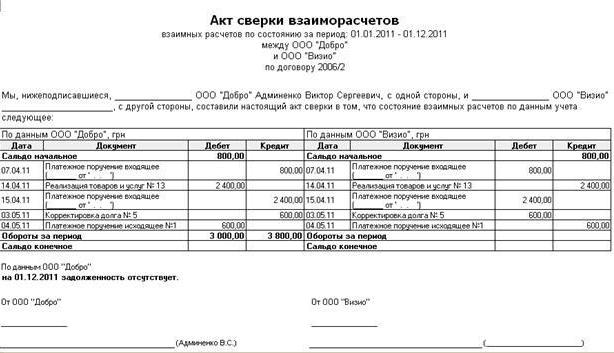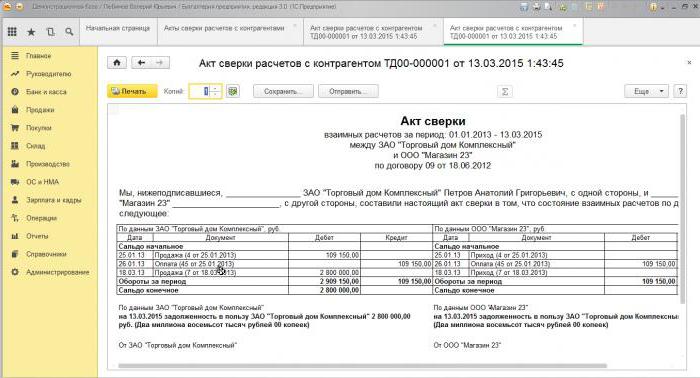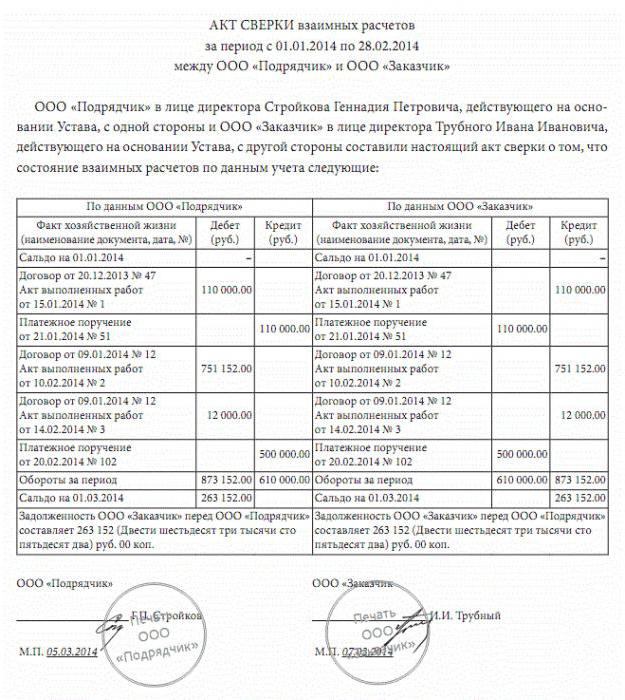How to draw up an act of reconciliation of mutual settlements?
Control is the key to running a successful business. When working with various contractors, one must have a good knowledge of information and do not forget to confirm the words with real numbers from time to time. It is for this that in modern document management there is an act of reconciliation of mutual settlements.
Document Description
Relationships between partners cannot be built on trust alone. In addition to feelings, there must be real facts that at any time can confirm or refute various suspicions. Any activity is actually connected with the acquisition or sale of something. Some produce goods or provide services, while others buy them by entering into an appropriate agreement. Both of them periodically need to audit their expenses.
To do this, they use the act of reconciliation of mutual settlements. In what cases does it become necessary to draw up such a document? The reasons can be very different:
- If one of the parties provides its goods without an advance payment or with an installment payment.
- In the case when a particularly valuable product is sold.
- The company has a large number of partners, each of which supplies goods in a fairly wide range.
- In the case of long-term and permanent cooperation of counterparties.
- In a situation where both parties decide to expand the scope of their relationship by entering into new agreements.
Any of these reasons may serve as a reason to request from your partner an act of reconciliation of mutual settlements. This should not be seen as distrust or prejudice.
Important details
Every accountant knows what an act of reconciliation of mutual settlements is. This is not surprising, because it is they who have to compose it. In this situation, an employee who owns certain information is required. To compile such a document, you have to raise data from different accounts:
- on previously issued advances;
- by income;
- according to the obligations assumed;
- according to existing shortages.
Only an accountant has access to such information. At the direction of the head, he collects the necessary information and draws them up in the form of a document of a certain sample. However, the chief accountant is ultimately responsible for the data provided. If there are no visible disagreements between the partners, then a similar form as a confirmation of the results of activities for a specific period. Some accountants act in this way when it turns out that the primary documents of transactions are lost or they are simply too lazy to look for them. However, this does not relieve them of responsibility for the information provided.
Procedure
How should an act of reconciliation of mutual settlements be drawn up? The sample filling will be a consistent presentation of specific information.

Any such act must contain the following information:
- Document's name.
- The period for which it was made.
- Name of counterparties.
- The basis of the transaction (agreement, agreement).
- Dates, numbers and specific figures taken from primary documents (payment orders, invoices and others). They contain information that will confirm the delivery or payment of the goods. Such information, for ease of perception, is usually collected in a table divided into two parts. In this case, each of the parties has the opportunity to indicate separately the data it has.
- Signatures of representatives of each of the parties.
The document must be drawn up in two copies so that each organization can keep it. The signature of the chief accountant must be mandatory here. And sometimes it can be the only one. This can be done in cases where there are no discrepancies in the data. Most often, the signature of the head of the enterprise is also required as confirmation.
Accounting automation
Some employees are interested in drawing up an act of reconciliation of mutual settlements, how to fill it out in the 1C: Accounting program? There are no particular difficulties here. Thanks to the computer, the work is much easier.

You just need to perform a few sequential operations:
- Go to the "Sales" or "Purchases" section (if necessary). Then in the tab "Settlements with counterparties" select "Act of reconciliation".
- Being inside the selected journal, click the "Create" button, and then go to the "Act of reconciliation with counterparties" tab. A dialog box will appear that can be filled in two ways: automatically or manually. The specialist chooses for himself exactly the one that he needs.
- Select the tab "According to the organization", then click "Fill" and specify the request with the button "Fill in according to accounting data". A list of all transactions performed will appear on the screen. If you need information on all contracts for the specified period, then you just need to check the box “Split by contracts”.
- Make a note "Reconciliation agreed."
- Find the "Additional" tab and select from the list of persons needed to sign the act.
It remains only to write down this document, and it will be possible to send it to print.
Rules for compiling a document
Accountants often have to make an act of reconciliation of mutual settlements. An example of compiling and filling out such a form is strictly individual for each organization. Considering that the law does not provide for any strict unified form for this, employees of any enterprise are forced to form it themselves, guided by general rules and requirements:
- Any act begins with a "header" with initial information about partners.
- Next comes the standard phrase that is used in all contracts. It states that the undersigned representatives of the two parties have drawn up this act, confirming that the following state of accounting.
- Following these words is the already known table. The first line in it is "balance at the beginning of the period." Next come the operations, divided into "debit" (performance of work or delivery of goods) and "credit" (payment). Then follows the balance at the end of this period. And the table ends with the calculation of debt.
- The signature of authorized persons must be confirmed by the round seal of the company.

Instead of the head, another person can sign the act. To do this, you need a power of attorney that will give him such powers. By the way, in court, its absence may cast doubt on the entire document.




